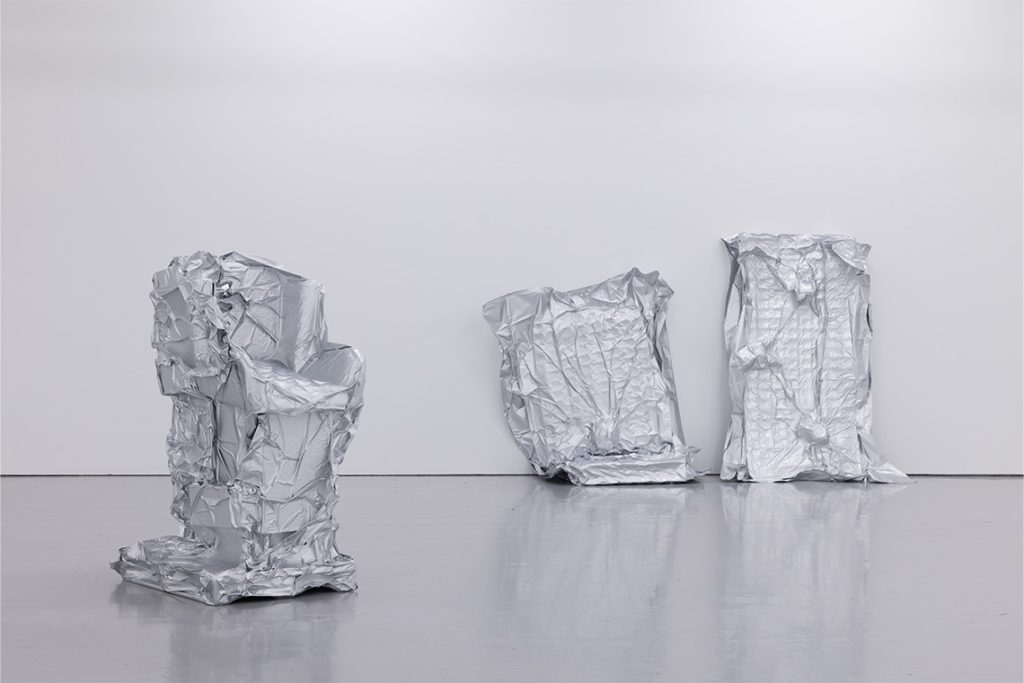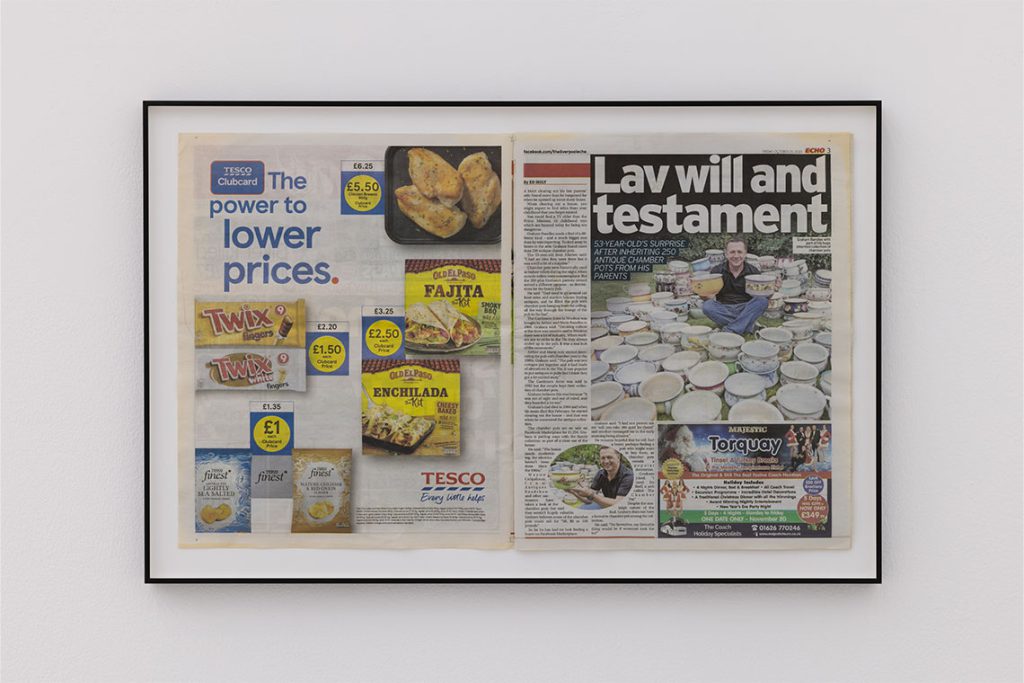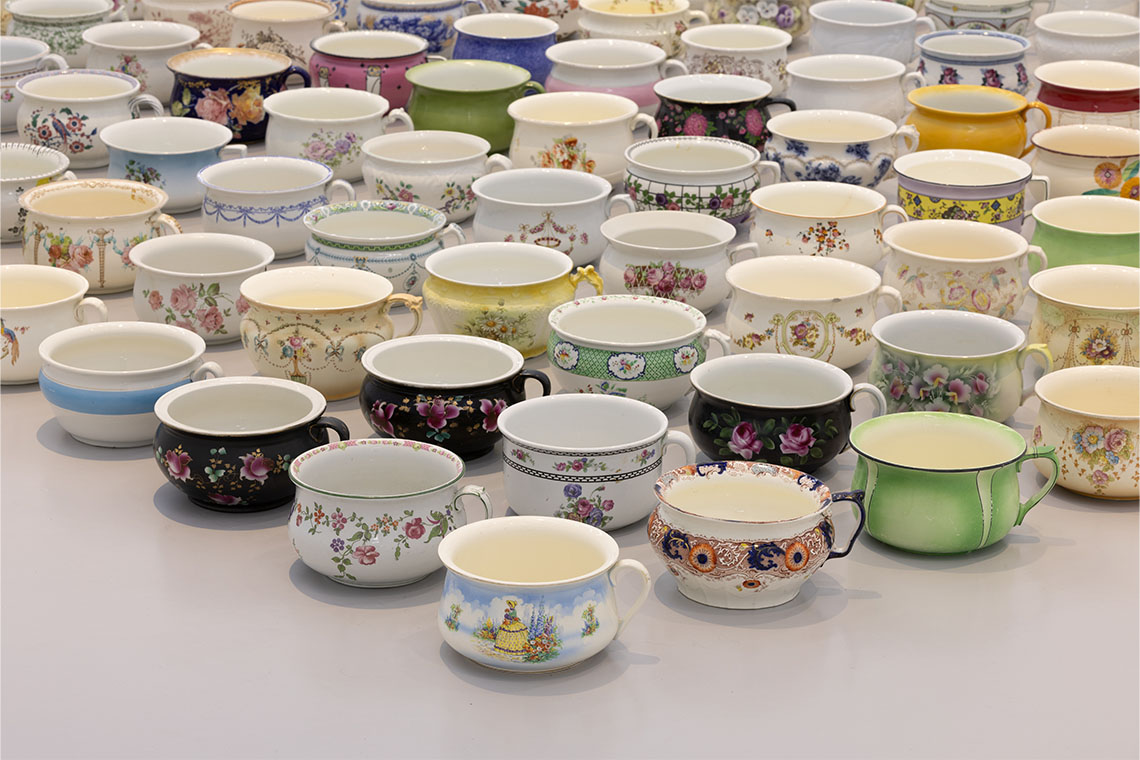Chamber pots, fly-tipped waste and The Spectator magazine are all among the unlikely tools Sophia Al-Maria and Lydia Ourahmane use to interrogate English identity in Grey Unpleasant Land at Spike Island.
“Nor shall my sword sleep in my hand; Till we have built Jerusalem In England’s green and pleasant land”. When English poet William Blake’s Jerusalem (1804–20) was set to music in 1916, it became something of an unofficial English national anthem, still sung at many a school assembly or wedding. Although instinctively I find myself bristling at anything with even a hint of flag-waving sentiment, this tune is rousing, even uplifting – such that it has been easy to conveniently overlook some of the less-than-savoury nationalistic emotion it has stirred. Whether or not that conflicts with Blake’s original vision, of course, is quite another question.
A play on these known-by-heart lyrics frames Sophia Al-Maria and Lydia Ourahmane’s show at Spike Island in Bristol, Grey Unpleasant Land. Both immigrants to the UK, Al-Maria and Ourahmane delve into the mythology that mediates and shapes English identity, challenging narratives of origin and belonging to examine England’s cultural and historical landscape – a rather more critical exploration than I was offered at school.
Walking into the not-for-profit gallery, set in one of the UK’s most progressive cities, you’re greeted by a sight that’s unusual in these parts: a stack of the conservative Spectator magazine. The top copy is open at a double page spread, bearing an artistic intervention by Al-Maria and Ourahmane. Titled Terra Nullius (2024), Latin for “nobody’s land”, the piece appears as an advertisement on one of the magazine’s open pages, reading: “Seeking English landowners burdened by carrying costs to participate in an endeavour of artistic significance”. On one level, the advertisement suggests the need to rectify long-standing inequalities in land distribution in England; on another, in its absurdity (we note the included phone number, which simply brings callers to the gallery’s reception desk, and the pointed use of “burdened” to describe land-rich individuals) it mocks and undermines the very concept of land ownership.

insects etc.), miscellaneous residues (cigarette ash, arsenic contaminants, urine etc.), aluminum bag, impulse seal, vacuum pack.
Installation view of Grey Unpleasant Land at Spike Island, Bristol, 2024. Photography by Rob Harris. Image courtesy of the artists and Spike Island
As I tower over the small stack to read the advert, the gallery attendant looks on slightly nervously. It’s tricky to read without getting dangerously close; one wrong move and the pile comes falling down. Exploring the space, this need for awkward positioning continues. With knees bent, I try to get a good look at the – close to the ground and easily missed – Lionheart (2016–24), an illuminated lion (England’s national animal) in shattered stained glass. My physical unease, often a literal lack of stability, mirrors the show’s destabilisation of the foundations of English identity building.
With the lion – associated with King Richard I, the Lionheart – in ruins, Al-Maria and Ourahmane continue the subversion by Terra Nullius of ownership (and particularly that passed by inheritance), taking aim at that other great British institution, which might be called the ultimate inheritance: the monarchy. In Birthright (2024), a pallet of Scottish sandstone weighing over a tonne, quarried from the same geological stratum as the Stone of Scone, casts doubt on the legitimacy of those born to rule. Far from the glory associated with that illustrious block of sandstone – captured during King Edward I’s invasion of Scotland and used in the coronation of English and British monarchs for over 500 years – this stone, wrapped in plastic, would not look out of place on a building site.
Set alongside, yet in its own room with a near chapel-esque feel, A Blessing and a Betrayal (2024) similarly undermines the concept of inheritance in relation to power and privilege in its reimagining of the biblical story of brothers Esau and Jacob, using ChatGPT. The traditional narrative, in which Esau is tricked out of his birthright (the responsibilities and blessings that come with being the oldest son) by Jacob, is often interpreted to show God’s selection of Jacob to carry on the Abrahamic Covenant over Esau. Presented via stained glass using the mediaeval silver stain method, the AI-generated text sees Esau – rather than lamenting his exclusion from the messianic lineage – embrace life without the blessings of his birthright, which included a double portion of inherited land. “For thou hadst found that the blessing thou seized brought chains instead of peace, that the land, though thine, had become a prison,” reads the new text.

Sophia Al-Maria and Lydia Ourahmane. Installation view of Grey Unpleasant Land at Spike Island, Bristol, 2024. Photography by Rob Harris.
Image courtesy of the artists and Spike Island
Mirroring the unequal inheritance of Jacob and Esau, Job Lot (late 1700s/2024) and Silver Service (1774/2024) put the concept of inheritance into the contemporary English context. Presented as a diptych and very much the heart of the exhibition (both because of their presentation in a separate central room and the scale of Job Lot in particular), the works examine inheritance through the possessions of two living individuals from starkly different English backgrounds. Graham Randles, the son of Liverpool pub owners, inherited 240 chamber pots of diverse (and often vibrant) colours and designs, originally acquired at auctions, markets and car boot sales to decorate the ceiling of the family pub. Arranged in neat rows on the floor, these are juxtaposed with Sir William Bellingham’s inheritance of a 250-year-old collection of George III silver, stored – and confined thereto in the exhibition – in heavy trunks. The chamber pots were sold to the artists via Facebook, as detailed in the exhibition by a clipping from The Liverpool Echo; the paper trail born of the bureaucratic nightmare the artists undertook to recover the silver from a NatWest bank vault in Stockport, on the other hand, betrays how – although both individuals chose to sell their inheritance – access to these objects, and the way they enter the market and new ownership, remains very different.
If two birthrights can serve as illustrations of the inequalities at play in English society, so too can what gets thrown out in the trash. Fly Tip (2024) showcases a collection of discarded belongings illegally dumped in and around Bristol, each one sealed in custom-made aluminium bags to contain potential contaminants. Curtain (2024) was salvaged from a bin outside 44 Kinnerton Street, Belgravia, during an estate clearance in 2020. The opulent yet fading red velvet of the drawn curtain of the latter stands in aesthetic contrast to the harsh reflections of the bright lights in the aluminium surfaces that characterise Fly Tip. Although the wrinkled bags that contain the dumped possessions are reminiscent of toxic waste disposal, something far more toxic belies the seemingly regal curtains: fly tipping seems like an inconsequential crime upon a Google search of 44 Kinnerton Street, which is revealed to have been home to former socialite and convicted sex trafficker Ghislaine Maxwell. This address is where British royal, Prince Andrew, is alleged to have slept with an underage girl trafficked by Jeffery Epstein. What before looked like mere fading opulence suddenly inspires disgust and fury.
Where to lay blame for the enduring weight of wealth and power, arbitrarily passed within families from one generation to the next, with privilege maintained regardless of moral failures? Al-Maria and Ourahmane suggest looking closer to home. Upon first encountering Framing Device I and Framing Device II (2024), before reading the caption some distance away, you could be forgiven for thinking that the works had been moved. These works showcase display fittings, which would frame a mediaeval treasure painted for another royal Richard: the Wilton Diptych (c.1395–99), showing King Richard II presented to the Virgin and Child by St John the Baptist and two English saints. According to the exhibition guide, the carrying frame, support frame and handling frame presented were provided by the National Gallery and have been essential to the rare late mediaeval panel painting’s preservation. In their titling of these display fittings as “framing devices”, Al-Maria and Ourahmane turn the interrogation lamp on galleries and museums themselves in a self-reflexive turn – few institutions have such scope to shape the cultural narrative, to elevate or minimise, and to affirm or undermine the power dynamics that characterise this Grey Unpleasant Land.



